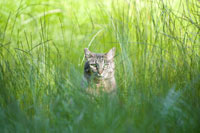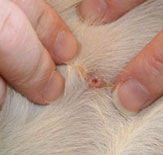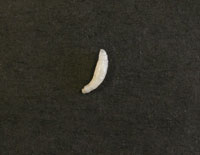
Your pet may become exposed to many parasites in their environment with warmer weather. One of those parasites is the larva of the Cuterebra fly that may cause a wound or sore on your pet's skin. Your pet is most likely to be affected in the summer and fall which corresponds to the most active egg-laying time for the adult fly.
What Is Cuterebra; How Can It Infect My Cat?
The Cuterebra fly is a large, non-biting fly that looks like a bee and lays its eggs on rocks or vegetation located near the openings of rabbit or rodent burrows. Some reports have suggested that eggs can be found in garden mulch that has been obtained near such areas.
The rabbit or wild rodent are the normal hosts and can pick up these eggs on their coats and ingest them during grooming. Cats and dogs may also be exposed in this manner by contacting the eggs as they pass near rabbit or rodent burrows in their environment. Eggs hatch once they are exposed to the warm body temperatures of their cat or dog hosts. The newly hatched larvae invade the host body often through the mouth, nasal passages, or an external wound.
The larva migrates to an area under the skin of the pet, typically on the head, neck, or trunk. A cyst or thick capsule is created under the skin as the larva grows; a circular breathing hole may appear as an open wound with matted hair around it. There is often fluid drainage from the opening and the animal, especially a cat, will groom the area excessively.
What Should I Expect to See If My Cat Has Been Infested by a Cuterebra Larva?
Warning:
Do not attempt to remove the larva yourself. Doing so may seriously harm your cat.
Most cats with Cuterebra will present to their veterinarian for an open wound or draining sore. If the pet has a long hair coat, the owner may notice an area of matted fur that appears to irritate the cat, causing excessive grooming at the site. Occasionally, the area may appear as a lump or swelling, which is also referred to as a warble. Owners may actually observe the caterpillar-like larvae sticking it’s head from the open hole at times to breathe, much like a swimmer periodically coming up for air.
Treatment of Cuterebra in Cats
Treatment for cuterebriasis should be performed by your veterinarian. It is important not to squeeze the swelling or cyst as it may damage the larva and release harmful chemicals into your pet's circulation. If the larva is ruptured during removal, it can cause serious complications including allergic reactions and anaphylaxis. Your veterinarian will administer local anesthesia at the site of the cyst or capsule and enlarge the breathing hole so the larvae can be removed in one piece. Your pet can experience repeated and chronic infections if any part of the larva is left behind. Even with complete and appropriate removal, healing may be slower than expected.
How to Prevent Cuterebra in Cats
Limit your pet's exposure to areas around rabbit and wild rodent nests or burrows to avoid Cuterebra infection. Cats should be kept indoors to prevent exposure. You should check your cat's coat or have them brushed or groomed regularly in an effort to remove eggs or larvae early in their development.
How Do I Know If Cuterebra Flies Are Found Where I Live?
If you live in the United States, you can be certain that some type of Cuterebra fly lives nearby. Cuterebra flies, also known as New World skin bot flies, are found throughout North and South America. There are over 72 different species of these flies that each target a specific host animal such as rabbits or deer.
Can I Catch Cuterebriasis From My Pet?
Humans can be infested with Cuterebra larvae but not from their pets. You may become exposed to the larvae in the same manner as your pet by contacting soil or mulch that is found near rabbit or rodent burrows. Wounds created by larvae under the skin do occur rarely in people and these follow the same path as infestations in cats and dogs. These are considered “accidental” infestations as they are caused by cuterebra that target wild animals for their hosts. There is one specific Cuterebra fly that does target humans as their host, but it is only found in South America.


Photos of Cuterbra infection and Cuterbra Larva ©GunDogDoc.com
You May Also Like These Articles:
Steatitis: Yellow Fat Disease in Cats
Cat Parasites
Worm Treatment and Prevention
Cat Fleas: Does My Cat Have Fleas?
How to Give a Cat a Bath
Cats and Milk
Cat Drooling
Disclaimer: This website is not intended to replace professional consultation, diagnosis, or treatment by a licensed veterinarian. If you require any veterinary related advice, contact your veterinarian promptly. Information at CatHealth.com is exclusively of a general reference nature. Do not disregard veterinary advice or delay treatment as a result of accessing information at this site. Just Answer is an external service not affiliated with CatHealth.com.







